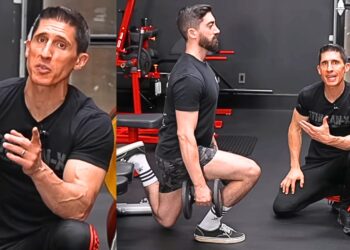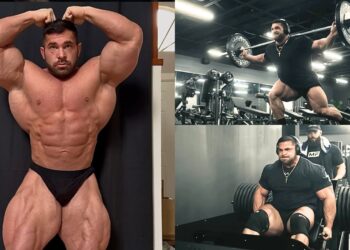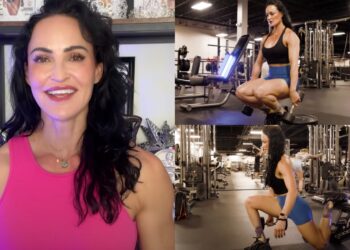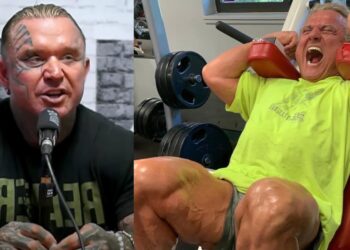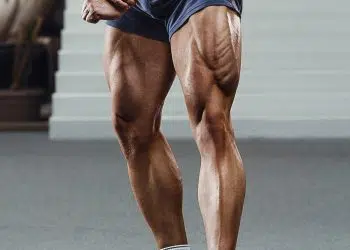Love them or hate them, leg workouts are non-negotiable for a well-rounded physique. A chiseled upper body is impressive, but without strong, developed legs, your physique won’t reach its full potential.
Building aesthetically pleasing legs is easier said than done. The quads have four muscle heads: the rectus femoris, vastus lateralis, vastus medialis, and vastus intermedius. Each exercise targets the quads from different angles, necessitating a thorough understanding of exercise biomechanics and human anatomy to pick the right movements for your workouts.
Building a jaw-dropping ‘X’ frame, characterized by wide shoulders, a narrow waist, and sprawling quads, requires you to focus on the vastus lateralis muscle.
As a seasoned personal trainer with over three decades of experience, I advise my clients to think about training their legs like a sculptor chisels a statue, paying attention to each muscle and shaping them carefully.
In this article, I reveal the eight most effective outer thigh exercises for developing that elusive quad sweep.
Recent Updates: On June 1, 2024, Fitness Volt’s Senior Editor, Vidur Saini (American Council on Exercise-CPT), revised the exercise list and added actionable expert tips throughout the piece to improve the reader experience.
Level Up Your Fitness: Join our 💪 strong community in Fitness Volt Newsletter. Get daily inspiration, expert-backed workouts, nutrition tips, the latest in strength sports, and the support you need to reach your goals. Subscribe for free!
8 Must-Do Outer Quad Exercises
Use these tried-and-tested exercises to beef up your outer thighs, hit your vastus lateralis hard, and build the quad sweep of your dreams:
1. Front squat
| Sets & Reps | 3-4 x 6-10 |
| Equipment Needed | Barbell, squat rack (optional: weightlifting shoes) |
| Target Muscles | Quadriceps (vastus lateralis, vastus medialis, vastus intermedius, rectus femoris), gluteus maximus, core, erector spinae, trapezius (upper) |
Squats are among the most effective leg exercises. In fact, they’re often called the king of exercises. However, while back squats are great, front squats tend to hit your quads the hardest, including that all-important vastus lateralis. Adopt a narrow stance to emphasize your outermost quad.
Saini recommends beginners perform this exercise with a wider stance as it enhances stability and promotes a more upright torso.
Steps:
- Put a barbell in a squat rack at about shoulder height.
- Walk forward and put your anterior (front) deltoids against the bar. Grip the bar with your hands just wider than shoulder-width apart.
- Push your elbows forward and under the bar so your upper arms are parallel to the floor.
- Brace your core and pull your shoulders down and back. Unrack the bar and take 1-2 steps back.
- Set your feet between hip and shoulder width apart.
- Bend your knees and hips at the same time. Descend as far as you can while keeping your torso upright, your elbows up, and your knees in line with your toes.
- Drive your heels into the floor and stand back up. Force your elbows upward as you ascend to stop the bar from rolling off your shoulders.
- Reset your core and repeat.
Coach Tips:
- Raise your heels on blocks to increase quads activation and squat deeper.
- Wear a weightlifting belt to increase lumbar stability and lift more weight.
- You can also do front squats using a Smith machine.
Benefits:
- An athletic, functional squatting exercise.
- Good for improving mobility and core strength.
- Hits your outer quads more than conventional squats.
- More lower back-friendly than barbell back squats.
| Difficulty | Intermediate |
| Progression | Back squat, Zercher squat, Overhead squat |
| Regression | Goblet squat |
Related: Front Squat Hypertrophy Guide
2. Leg extension
| Sets & Reps | 3-4 x 10-15 |
| Equipment Needed | Leg extension machine |
| Target Muscles | Quadriceps (vastus lateralis, vastus medialis, vastus intermedius, rectus femoris) |
Most leg exercises involve your hips and knees. This means they not only train your quads but your glutes and hamstrings, too. Leg extensions only involve movement at the knee joint, so they isolate your quadriceps. This is an excellent exercise to bias your quads.
“Aim for a five-second descent,” recommends Saini. “It increases the time under tension (TUT) and can help promote hypertrophy.”
Steps:
- Sit on the leg extension machine, so your knees align with the edge of the seat. Adjust the backrest for comfort and support.
- Position your legs close to each other to load the outer sweep.
- Place your ankles behind the lower leg pad. Grip the handles by your sides.
- Smoothly extend your legs until your knees are straight. Do not kick the weight up, as doing so creates momentum and takes tension off your quads.
- Pause in the top position for 1-2 seconds.
- Bend your knees and lower the weights.
- Repeat.
Coach Tips:
- You can also do leg extensions with a dumbbell clamped between your feet.
- Pause at the top of each rep to increase time under tension.
- Pull your toes up toward your shins to increase quads activation.
Benefits:
- Highly accessible, as most gyms have a leg extension machine.
- An easy exercise to learn and master, so it’s ideal for beginners.
| Difficulty | Beginner |
| Progression | Single-leg leg extension, Bulgarian split squat (machine variation) |
| Regression | Dumbbell leg extension |
3. Narrow stance leg press
| Sets & Reps | 3-4 x 8-12 |
| Equipment Needed | Leg press machine |
| Target Muscles | Quadriceps (all four heads), gluteus maximus, adductors (magnus, longus, brevis) |
The leg press is another classic quad exercise. With your back supported, you can focus on pushing your legs to their limit. With care, you can also train to failure. Just flip the safety catches inward when you cannot do any more reps. Using a narrow stance increases outer thigh activation.
Saini suggests that you focus on driving through your big toe and heels as you press to shift the emphasis to the quads.
Steps:
- Sit on the leg press and put your feet on the footplate, so they are hip-width apart or closer.
- Extend your legs and flip the weight safety catches to the side.
- Bend your legs and lower the weight as low as possible without rounding your lower back or straining your knees.
- Push the weight back up and repeat.
Coach Tips:
- Do this exercise with one leg at a time to identify and fix any left-to-right strength imbalances, and strengthen your mind-muscle connection.
- Move your feet down the footplate to maximize quad engagement.
- Contract your quads as hard as possible at the top of each rep to make your workout more effective.
Benefits:
- A very lower back-friendly exercise.
- Ideal for beginners as it is a very straightforward movement.
| Difficulty | Beginner |
| Progression | Single-leg leg press, Bulgarian split squat (machine variation) |
| Regression | Seated leg press with wider stance |
4. Hack squat
| Sets & Reps | 3-4 x 8-12 |
| Equipment Needed | Hack squat machine |
| Target Muscles | Quadriceps (all four heads), gluteus maximus, adductors (magnus, longus, brevis) |
Named after old-time weightlifter and wrestler George Hackenschmidt, the hack squat fixes your lower back and hips in position, so your quads must do more of the work. Hackenschmidt was known for his incredible thigh development, and this exercise is partly why.
Saini prescribes keeping your feet close to the bottom of the footplate to maximum knee flexion and achieve a deep quad stretch at the bottom of your range of motion (ROM).
Steps:
- Stand on the platform with your feet about hip-width apart, toes pointing forward. Put your shoulders under the pads and your back against the backrest. Extend your legs and release the safety catches.
- Bend your legs and squat down, allowing your knees to travel forward. Keep your back pressed into the backrest.
- Drive your feet into the floor and stand back up.
Coach Tips:
- Use a hip-width stance to emphasize your outer quads.
- Keep your hips back and drive your knees forward to maximize quad engagement.
- Squeeze your quads at the top of each rep for a more effective workout.
Benefits:
- Easy to learn and a good exercise for beginners.
- Lower-back friendly.
| Difficulty | Beginner to Intermediate (depending on machine) |
| Progression | Increase weight, barbell hack squat |
| Regression | Leg press |
Related: Hack Squat Guide
5. Short step walking lunge
| Sets & Reps | 3 x 10-12 steps per leg |
| Equipment Needed | Dumbbells (optional) |
| Target Muscles | Quadriceps (all four heads), gluteus maximus, hamstrings (biceps femoris, semitendinosus, semimembranosus) |
Walking lunges are a very effective lower-body exercise. However, to load your quads, a shorter step works best. Using a shorter step increases the range of motion of your front knee, maximizing quad stretch at the bottom.
A bigger ROM also means your vastus lateralis has a little more work to do. But be warned: This is a taxing exercise, and a little weight goes a long way, so don’t go too heavy too soon.
Steps:
- Stand with your feet together and your arms by your sides. Adopt a good posture and look straight ahead.
- Step forward about two feet, bend your legs, and lower your rear knee down to the floor.
- Push off your back leg and through into another rep.
- Continue for the desired number of reps.
Coach Tips:
- Make this exercise even more challenging by wearing a weighted vest or holding a dumbbell in each hand.
- Short on space? Do short-step alternating lunges instead.
- Keep your torso upright to ensure that your quads do more work than your glutes or hamstrings.
Benefits:
- A very functional quads-centric lower body exercise.
- Good for developing balance and mobility.
- Very lower-back friendly.
| Difficulty | Intermediate |
| Progression | Reverse lunge, lateral lunge, Bulgarian split squat |
| Regression | Stationary lunge |
6. Sissy squat
| Sets & Reps | 3 x 10-15 |
| Equipment Needed | None (optional: sissy squat machine or something to hold for support) |
| Target Muscles | Quadriceps (primarily rectus femoris), core |
The sissy squat is an old-school bodybuilding exercise that hammers your quads without needing huge weights. Adopt a narrow stance to emphasize your outer quads and build that thigh sweep you’ve always dreamed of!
Keep your entire spine, including your neck, in a neutral position throughout the movement to protect your lower back and bias the quads, says Saini.
Steps:
- Stand next to a wall or some other object you can use for balance.
- Rise up onto your tiptoes.
- Push your hips and knees forward and squat down as you simultaneously lean back. Descend as far as you can, ideally until your shins are roughly parallel to the floor.
- Drive your toes into the floor and stand back up.
- Tense your quads and glutes at the top of each rep and repeat.
Coach Tips:
- If flexibility allows, descend until your knees lightly touch the floor.
- The more you lean back, the more challenging this exercise becomes.
Benefits:
- No equipment is required.
- An excellent alternative to leg extensions.
- Easy to load by wearing a weighted vest or holding a weight plate against your chest.
| Difficulty | Advanced |
| Progression | Weighted sissy squat, pistol squat |
| Regression | Assisted sissy squat (using a machine or object for support) |
7. Heels elevated goblet squat (aka cyclist squat)
| Sets & Reps | 3-4 x 10-15 |
| Equipment Needed | Dumbbell or kettlebell, weight plates or blocks for heel elevation |
| Target Muscles | Quadriceps (vastus medialis emphasis), gluteus maximus |
Have you ever noticed how massive and ripped track cyclists’ legs are? While bike sprinting is part of the reason, this “secret” exercise is also a contributing factor. Not only is this a killer quad exercise, but it’s also pretty low-tech, so it’s ideal for home lifters.
“As you squat down, actively drive your knees forward and outward to maximize quad activation,” says Saini.
Steps:
- Place two bumper weight plates on the floor about hip-width apart. Stand with your heels raised and the balls of your feet on the floor. Your feet should be parallel.
- Hold a kettlebell in front of your chest and just below your chin. Pull your shoulders down and back, and brace your core. Look straight ahead.
- Keep your torso upright, bend your knees, and squat as deeply as possible without rounding your lower back.
- Stand up, stopping just short of locking your knees to keep the tension on your quads.
- Descend again and repeat for the required number of repetitions.
Coach Tips:
- Do this exercise with a dumbbell if you don’t have access to kettlebells.
- Vary the height of your heel raise to see what works best for you.
- Drive your knees forward and over your toes to target your quads more. Contrary to popular opinion, squats with your knees in front of your toes are not bad for your joints, providing you have no pre-existing knee problems.
Benefits:
- A very quads-centric compound leg exercise.
- A very safe exercise; drop the weight in front of you if you cannot complete a rep.
| Difficulty | Beginner |
| Progression | Barbell front squat, heels elevated barbell front squat |
| Regression | Regular goblet squat |
Related: Heels Elevated Goblet Squats
8. Wall squat
| Sets & Reps | 3 x 30-60 seconds hold |
| Equipment Needed | None |
| Target Muscles | Quadriceps (all four heads), gluteus maximus |
The great thing about this exercise is that the only thing you need to do them is a wall. Wall squats are an overcoming isometric exercise, which means you use your muscles to generate force against an immovable object. The harder you push, the more challenging the exercise will be, and the more effective your workout becomes.
Steps:
- Lean your back against a wall and place your feet about two feet in front of you. Your feet should be about hip-width apart. Slide down the wall until your thighs are about parallel to the floor.
- Drive your feet forward and down, and push your lower back into the wall as hard as possible. Try to generate as much muscle tension as possible.
- Keep pushing for 20-30 seconds.
Coach Tips:
- Do this exercise before lunges, bodyweight squats, squat jumps, etc., for a much more intense bodyweight-only leg workout.
- Do this on one leg for a more challenging quads workout.
- Adjust the height of your squat to target the quads from different angles. The deeper you squat, the more stretched your quads will be, and the harder they’ll have to work.
Benefits:
- No equipment is required — it’s the perfect excuse-free quads exercise.
- The harder you push, the more effective this exercise becomes, so it’s ideal for people of all experience levels.
- A very knee and lower-back-friendly exercise.
| Difficulty | Beginner |
| Progression | Increase hold time, add weight (hold a plate or dumbbell) |
| Regression | Wall sit with a shorter hold time |
Outer Quad Workout
While you could just add a few of these exercises to your usual leg workout in the hope that you’ll build bigger outer quads, you’ll get better results if you follow a more structured program.
Do this workout twice a week to build bigger outer quads and improve your quad sweep.
But before you begin, spend a few minutes warming up and preparing your muscles and joints for what you’re about to do. Start with 5-10 minutes of easy cardio, followed by dynamic mobility and flexibility exercises for your ankles, knees, hips, and lower back.
Finally, try to increase your weights or reps performed from one week to the next so your muscles are continually challenged and continue to grow.
Follow this workout for 4-6 weeks or until you feel it is no longer working.
| # | Exercise | Sets | Reps | Recovery |
| 1a | Leg extension | 3 | 8-10 | 2 minutes |
| 1b | Heels elevated goblet squat | |||
| 2 | Short-step walking lunge | 3 | 12-15 per leg | 90 seconds |
| 3 | Sissy squat | 2 | 15-20 | 90 seconds |
| 4 | Wall squat | 2 | 20-30 seconds | 60 seconds |
Exercises 1a and 1b are to be performed as a superset. So, do one set of leg extensions and then, without resting, do a set of goblet squats. Then, rest for the prescribed time and repeat the pairing for three more supersets, totaling four.
Get to Know Your Quads
While you don’t need a degree in anatomy to build an impressive quad sweep, it’s often helpful to know a little about the muscles you are training so you can pick the best exercises for the job.
The quadriceps (full name, quadriceps femoris) are actually made up of four muscles (1):
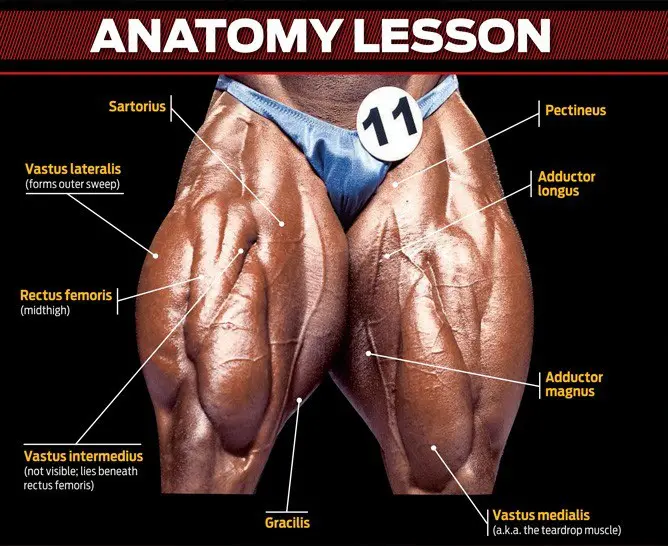
Rectus femoris
The rectus femoris is the longest of the quadriceps muscles. It’s biaxial, which means it crosses both your hip and your knee. Its functions are knee extension and hip flexion.
Vastus medialis
The vastus medialis is the shortest of the quad muscles and is located toward the midline of your lower thigh. It’s a uniaxial muscle, crossing only your knee joint. This muscle is often called the teardrop quad. The lowermost fibers run almost horizontally, and this part is often called the vastus medialis oblique, or VMO for short. The VMO extends the knee and also helps stabilize the patella or kneecap.
Vastus intermedius
This quad is located toward the center of your thigh. Like the vastus medialis, it’s a uniaxial muscle that extends your knee. The vastus intermedius is the largest of the four quad muscles and gives your thighs most of their size.
Vastus lateralis
The vastus lateralis is your outermost quad and the muscle you need to target to develop a great-looking quad sweep. Just like the other vastus muscles, the vastus lateralis extends your knee.
There is no scientific evidence to suggest that you isolate the vastus lateralis muscle. The quadriceps work together to extend your knees. Only the rectus femoris works in isolation, i.e., during hip flexion.
However, bodybuilders believe that certain exercises emphasize the vastus lateralis, and their impressive results support this. So, while officially, there are no outer quad exercises, it is still possible to develop this muscle to create a more impressive quad sweep.
Level Up Your Fitness: Join our 💪 strong community in Fitness Volt Newsletter. Get daily inspiration, expert-backed workouts, nutrition tips, the latest in strength sports, and the support you need to reach your goals. Subscribe for free!
How to Stretch Your Quads
While your quads need to be strong and muscular to look their best, flexibility is also important, especially if you want them to function correctly.
Inflexible quads are prone to injury and could even limit your range of motion, making your workouts less effective than they should be. If your quads are tight, you won’t be able to squat or lunge as deeply, and that means less quads engagement.
The good news is that the quads are very easy to stretch. A few minutes of flexibility work after your strength workout is all you really need to maintain or improve quadriceps flexibility.
Here are five great quads stretches to try. You don’t need to do all of them. Instead, just pick 1-2 and do them for 30-60 seconds, remembering to spend equal time on both legs.
1. Standing quadriceps stretch
This simple exercise is ideal for when you want a quick quad stretch that you can do without equipment or having to lie down, e.g., before you go for a run. Because it’s so straightforward, this is the ideal exercise if you want to stretch your quads several times a day. In fact, you could get up and do it right now!
How to do it:
- Stand with your feet together and arms by your sides. Adopt a good, upright posture. Bend your knees slightly for balance.
- Shift your weight over onto one foot and then bend your leg behind you. Reach back and grip the top of your ankle with one or both hands. Keep your shoulders down and back, and look straight ahead.
- Gently pull your foot toward your butt to lengthen and stretch your quads. Keep your thighs together throughout.
- Hold for 30-60 seconds, increasing the stretch as your muscles relax and lengthen.
- Lower your foot to the floor, swap legs, and repeat.
Pro tips: Get a deeper quads stretch by pushing your hips forward. This hits the rectus femoris a little more. Lean against a wall if you find it difficult to maintain your balance.
2. Prone quadriceps stretch
Stretching your quads while standing is convenient, but it’s probably not the best exercise if you want to do a prolonged stretch, e.g., 60 seconds or more. That’s where this stretch comes in! The prone quads stretch is very comfortable and ensures that your hips and knees are correctly aligned.
How to do it:
- Lie flat on the floor with your legs straight and your head resting on your folded arms.
- Bend your left leg, reach back with your left arm, and hold your ankle.
- Gently pull your foot toward your butt, taking care not to lift your shoulders or twist your back. Your thigh should remain in contact with the floor.
- Remain in position for 30-60 seconds or more, increasing the stretch as you feel your muscles relax and lengthen.
- Release your foot, swap sides, and repeat.
Pro tip: If you find it hard to reach your foot without straining, use a yoga strap to “lengthen” your arms. Loop the strap over your foot and then grip it so you don’t have to reach back so far.
3. Side-lying quadriceps stretch
Lying on your front can be uncomfortable for some people, especially if you are overweight, pregnant, or have a sore lower back. Some people may find this side-lying quad stretch more accessible. As an added advantage, you will still be able to see what’s happening around you.
How to do it:
- Lie on your side with your hips stacked, shoulders square, and legs together. Rest your head on your outstretched arm.
- Bend your uppermost leg and reach back to grab your ankle.
- Gently pull your foot into your butt.
- Remain in position for 30-60 seconds or more, increasing the stretch as you feel your muscles relax and lengthen.
- Release your foot, roll over, swap sides, and repeat.
Pro-tip: Increase the stretch by pushing your top hip forward slightly. This puts more emphasis on the rectus femoris muscle.
4. Half-kneeling quads stretch
Most quads stretches are done with the knees together. While this is good for joint health, it’s not so good for hitting the rectus femoris. The half-kneeling quads stretch extends your hip, so the rectus femoris is lengthened and gets a more intense stretch. However, this is a more demanding exercise and may be difficult if you have poor mobility.
How to do it:
- Adopt a half-kneeling position with one foot flat on the floor in front of you and your opposite knee roughly two feet behind.
- Bend your rear leg, grasp your ankle, and pull your foot into your butt. Keep your torso upright, do not twist your hips or shoulders, and do not hyperextend your lumbar spine.
- Remain in position for 20-60 seconds or more, increasing the stretch as you feel your muscles relax and lengthen.
- Release your foot, swap sides, and repeat.
Pro tips: For comfort, place your knee on a folded towel or use a foam pad.
5. Foam rolling the quadriceps
Your muscles are surrounded by a thin layer of fibrous tissue called fascia. Fascia separates and connects each muscle from its neighbor. This fascia can become “gummed up,” leading to tight, painful muscles. This can cause trigger points, poor blood flow, and reduced function.
Foam rolling is a form of self-massage called self-myofascial release that can help free up your fascia and restore normal movement and function. Foam rolling your quads will enhance knee and hip joint mobility and performance.
How to do it:
- Lie on your front on your foam roller. The roller should be under your thighs. Shift your weight across to emphasize one leg at a time. Bend the knee on the leg you want to work on.
- Roll back and forth along your thigh, turning your leg in and out to hit all four quads.
- Seek out any areas of tightness and spend a little longer working on them until they start to diminish.
- Increase the pressure by crossing your other leg over the one you’re treating.
- Continue for 2-4 minutes, and then swap sides.
Pro tip: Foam rolling can be painful. But, as the adhesions start to dissolve, subsequent foam rolling sessions should be less uncomfortable. Increase the pressure gradually to avoid unnecessary pain.
FAQs
1. Is it possible to isolate the outer quads?
While each of the quadriceps has a separate origin point, all four come together at a shared insertion. This means the quadriceps always work together. As such, you cannot isolate the outer quads from the other three.
However, it is possible to emphasize the outer quad so it is a little more active. In most cases, this means adopting a narrow stance and using a large range of motion. The exercises outlined in this article are among the best for hitting the outer quads. However, the other three quads are also working.
2. How many sets and reps should I do to develop my quads?
It’s generally accepted that, to build muscle, you should do between 10-20 sets per week to build a muscle or muscle group (2). You can do all the sets in one workout or spread them across several workouts as preferred.
For reps, anywhere from 6-35 will lead to muscle growth, providing you take your sets close to failure. However, because leg exercises can be very taxing and may leave you feeling out of breath, it’s often best to limit your workouts to 20 reps or less per set.
But, if you want to build strength, heavy weights and low reps work best, and most of your training should be done in the 3-5 rep range.
Read more about sets, reps, and training to failure in this article.
3. How often should I train my quads?
It’s generally best to train your quads twice a week, e.g., Monday and Thursday. This will save you from having to cram all your sets into a single workout. Also, doing fewer sets in a workout means you’ll be able to train harder, which may lead to better results.
You CAN train your legs once per week, but more frequent workouts are usually more effective. Delayed onset muscle soreness is also less when you train more often.
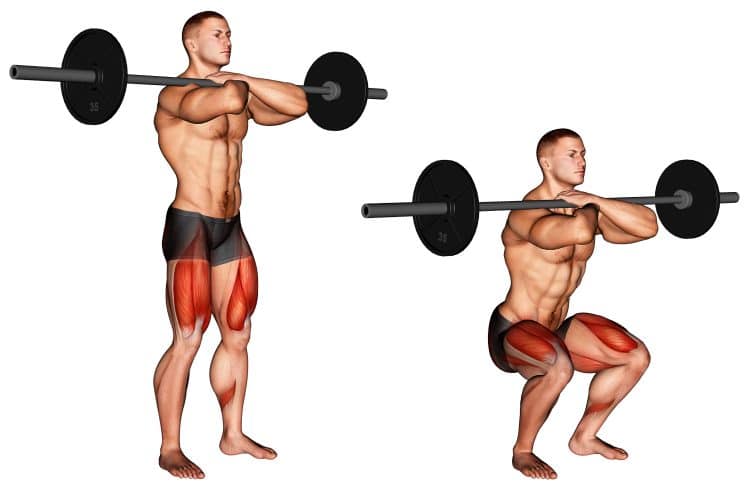
4. Are bodyweight exercises good for building the quads?
You can build muscle with bodyweight exercises, but you’ll have to do high reps to take your muscles close to failure. For example, when doing bodyweight squats, you may need 50, 70, or more reps to fatigue your quads.
Such high-rep sets are time-consuming and can be hard on your cardiovascular system. Plus, doing 2-3 minutes of squats will probably be boring.
Using weights means you won’t have to do as many reps, making your workouts more time-efficient. However, if you don’t have any weights available, and providing you do enough reps, you can build your quads with bodyweight exercises.
5. Some quad exercises hurt my knees. What should I do?
If an exercise causes pain, you should stop doing it.
But, of course, we’re talking about knee pain, as intense training is sure to make your muscles burn!
If you are experiencing knee pain, make sure you are doing the exercise correctly, as improper exercise form will put stress on your joints. Next, make sure you aren’t using too much weight.
Finally, if an exercise still bothers your knees, switch to an alternative that doesn’t cause joint pain. Some exercises are harder on your knees than others, and it could be that the movement you’re doing simply doesn’t suit you. For example, if sissy squats hurt your knees, try reverse deficit lunges or cyclist squats instead.
Closing Thoughts
While it is impossible to isolate your outer quads, proper name vastus lateralis, it is possible to emphasize it by performing specific exercises and using special techniques. For example, squats with a narrow stance are a great way to hit your outer quads, as are leg extensions with your legs turned slightly inward.
Working on your outer quads can help make your thighs wider. However, it’s important not to neglect your medial quads and adductors as they fill out your inner thighs. Wide stance squats are among the best exercises for this part of your legs.
Finally, remember that the shape of your legs is largely genetic, and while you can always make them bigger, you may not be able to create a perfect quads sweep. That said, you won’t know until you try!
References:
- KenHub: Quadriceps Femoris Muscle https://www.kenhub.com
- PubMed: Total number of sets as a training volume quantification method for muscle hypertrophy: a systematic review https://pubmed.ncbi.nlm.nih.gov/30063555/
Interested in measuring your progress? Check out our strength standards for Overhead Squat, Zercher Squat, Bulgarian Split Squat, and more.



